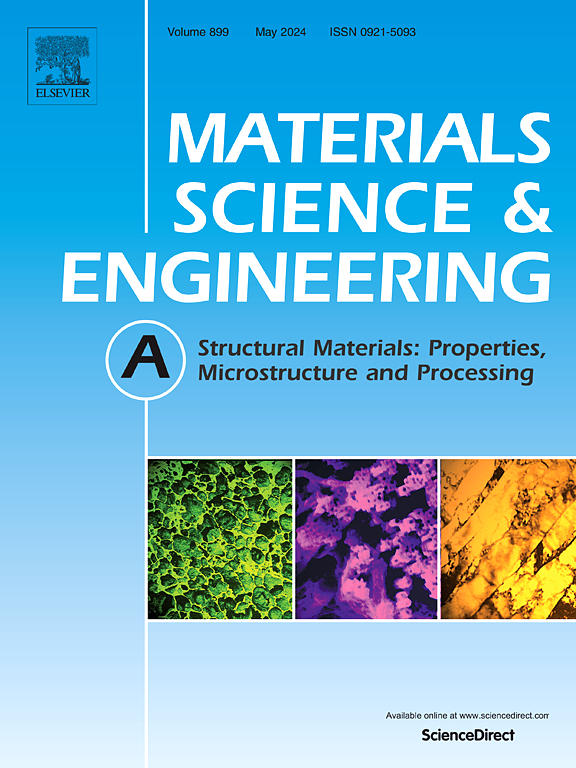Deformation behavior and strengthening mechanism analysis of newly designed Co31.5Fe18.5Ni31.5Al18.5 eutectic high-entropy alloy by calculating solidification paths
IF 6.1
2区 材料科学
Q1 MATERIALS SCIENCE, MULTIDISCIPLINARY
引用次数: 0
Abstract
A novelCo31.5Fe18.5Ni31.5Al18.5 eutectic high-entropy alloy (EHEA) is designed through computational prediction of solidification paths using JMatPro. The microstructure features eutectic dendrites and cells, with the two-phase eutectic showing characteristic lamellar structures of alternating NiAl-rich B2 (ordered BCC) and CoFeNi-rich L12 (ordered FCC) phases. TEM analysis reveals a semi-coherent relationship between BCC and FCC phases, i.e., [011]FCC// BCC and FCC// BCC. The Co31.5Fe18.5Ni31.5Al18.5 EHEA exhibits a yield strength of 571 ± 15 MPa and an ultimate strength of 975 ± 5 MPa with a ductility of 6.9 ± 0.3 %. Deformation behavior is well understood through comprehensive analysis of fracture surface morphology, side surface characteristics, and tensile-induced substructure evolution. Extensive plastic deformation in the FCC phase is evidenced by pronounced necking, fine shear bands, and high-density dislocation networks. In contrast, the BCC phase displays quasi-cleavage fracture characteristics with limited dislocation activity, indicating restricted plastic deformation capability. The strengthening mechanisms (like mixing rule, interface strengthening and HDI stress strengthening) are discussed in detail. In particular, the investigation of the mechanical properties of FCC and BCC individual phases represents the most significant highlight of this work, which provides critical insights into the strengthening mechanisms of EHEAs.
通过计算凝固路径分析新设计Co31.5Fe18.5Ni31.5Al18.5共晶高熵合金的变形行为及强化机理
利用JMatPro软件对凝固路径进行计算预测,设计了新型co31.5 fe18.5 ni31.5 al18.5共晶高熵合金(EHEA)。微观结构以共晶枝晶和细胞为特征,两相共晶呈现富nial B2(有序BCC)和富cofeni L12(有序FCC)相间的片状结构特征。TEM分析揭示了BCC和FCC阶段之间的半相干关系,即[011]FCC// [1 - 11] BCC和(1 - 1 - 1)FCC//(011) BCC。Co31.5Fe18.5Ni31.5Al18.5 EHEA的屈服强度为571±15 MPa,极限强度为975±5 MPa,塑性为6.9±0.3%。通过综合分析断裂表面形貌、侧面特征和拉伸诱导的子结构演变,可以很好地了解变形行为。FCC阶段广泛的塑性变形表现为明显的颈缩、细小的剪切带和高密度的位错网络。相反,BCC相表现出准解理断裂特征,位错活动有限,表明塑性变形能力有限。详细讨论了混合规律、界面强化和HDI应力强化等强化机理。特别是,FCC和BCC各相力学性能的研究是本研究的最重要亮点,为EHEAs的强化机制提供了重要的见解。
本文章由计算机程序翻译,如有差异,请以英文原文为准。
求助全文
约1分钟内获得全文
求助全文
来源期刊

Materials Science and Engineering: A
工程技术-材料科学:综合
CiteScore
11.50
自引率
15.60%
发文量
1811
审稿时长
31 days
期刊介绍:
Materials Science and Engineering A provides an international medium for the publication of theoretical and experimental studies related to the load-bearing capacity of materials as influenced by their basic properties, processing history, microstructure and operating environment. Appropriate submissions to Materials Science and Engineering A should include scientific and/or engineering factors which affect the microstructure - strength relationships of materials and report the changes to mechanical behavior.
 求助内容:
求助内容: 应助结果提醒方式:
应助结果提醒方式:


